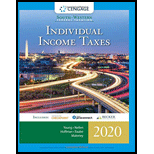
Individual Income Taxes
43rd Edition
ISBN: 9780357109731
Author: Hoffman
Publisher: CENGAGE LEARNING - CONSIGNMENT
expand_more
expand_more
format_list_bulleted
Question
Chapter 20, Problem 9DQ
To determine
Explain whether the statement related to donation to a qualified charity is correct.
Expert Solution & Answer
Want to see the full answer?
Check out a sample textbook solution
Students have asked these similar questions
Southern Company leased high-tech electronic equipment from Edison Leasing on January 1, 2024. Edison purchased the equipment from International Machines at a cost of $136,768.
2 year lease, with 8 quarterly payments of $18,000 each, 6% interest rate.
What is the amortization schedule for this loan starting Jan 1, 2024?
Questi 8
Price and Efficiency Variances (22 points)
The Livingston Corporation manufactures lamps. It has set up the following standards per finished unit
for direct materials and direct manufacturing labor:
「
Direct Materials: 10 lb. at $5.20 per lb.
Direct Manufacturing Labor: 0.5 hour at $30 per hour
$52
$15.00
The number of finished unit budgeted for January 2017 was 9,940; 9,900 units were actually produced.
Actual Results in January 2017 were as follows:
1.200
Direct Materials: 97,500 lb. used
Direct Manufacturing Labor: 4,900 hours
budg
$155,575
During the month, materials purchases amounts to 99,400 lb., at a total cost of $536,760. Input price
variances are isolated upon purchase. Input efficiency variances are isolated at the time of usage.
Requirement
Computer the January 2017 price and efficiency variances of direct materials and direct manufacturing
labor. (Put a U for Unfavorable and a F for Favorable variances)
53670
Actual Costs Incurred
Costs
(Actual Input Qty.
Actual Input…
Chapter 20 Solutions
Individual Income Taxes
Ch. 20 - Prob. 1DQCh. 20 - LO.1 Sylvia and Trang want to enter into business...Ch. 20 - Prob. 3DQCh. 20 - Prob. 4DQCh. 20 - Prob. 5DQCh. 20 - LO.3, 4, 5 Contrast the income taxation of...Ch. 20 - LO.3, 8, 9 The taxpayer has generated excess...Ch. 20 - Prob. 8DQCh. 20 - Prob. 9DQCh. 20 - Prob. 10DQ
Ch. 20 - Prob. 11DQCh. 20 - Prob. 12DQCh. 20 - Prob. 13DQCh. 20 - Prob. 14DQCh. 20 - LO.5 Beige Corporation has a fiscal year ending...Ch. 20 - Prob. 16DQCh. 20 - Prob. 17DQCh. 20 - Prob. 18DQCh. 20 - Prob. 19DQCh. 20 - Prob. 20DQCh. 20 - Prob. 21DQCh. 20 - Blaine, Cassie, and Kirstin are equal partners in...Ch. 20 - LO.3 Green Corporation, a calendar year taxpayer,...Ch. 20 - Prob. 24CECh. 20 - Prob. 25CECh. 20 - LO.4 Gold and Silver are two unrelated calendar...Ch. 20 - Prob. 27CECh. 20 - Prob. 28CECh. 20 - Prob. 29CECh. 20 - Prob. 30CECh. 20 - Prob. 31CECh. 20 - Prob. 32CECh. 20 - Prob. 33CECh. 20 - LO.3, 4, 5 Using the legend provided below,...Ch. 20 - LO.3 Garnet incurs the following capital asset...Ch. 20 - Prob. 36PCh. 20 - LO.3 Taupe, a calendar year taxpayer, has a...Ch. 20 - LO.3, 8 Robin incurred the following capital...Ch. 20 - Prob. 39PCh. 20 - Prob. 40PCh. 20 - Prob. 41PCh. 20 - Prob. 42PCh. 20 - Prob. 43PCh. 20 - Prob. 44PCh. 20 - Prob. 45PCh. 20 - Prob. 46PCh. 20 - Prob. 47PCh. 20 - Prob. 48PCh. 20 - Prob. 49PCh. 20 - Prob. 50PCh. 20 - During the current year, Thrasher (a calendar...Ch. 20 - Prob. 52PCh. 20 - Prob. 53PCh. 20 - Prob. 54PCh. 20 - Prob. 55PCh. 20 - LO.9 The Pheasant Partnership reported the...Ch. 20 - Prob. 57PCh. 20 - Prob. 58PCh. 20 - Prob. 59PCh. 20 - Prob. 1RPCh. 20 - Prob. 2RPCh. 20 - Prob. 3RPCh. 20 - Prob. 5RPCh. 20 - On January 1, year 5, Olinto Corp., an accrual...Ch. 20 - Prob. 2CPACh. 20 - Prob. 3CPACh. 20 - Prob. 4CPACh. 20 - Prob. 5CPACh. 20 - Prob. 6CPACh. 20 - Prob. 7CPA
Knowledge Booster
Similar questions
- Maple Grove Trading presents the following financial information Description Operating Expenses Amount 60,000 Sales Returns and Allowances 7,000 Sales Discounts Sales Revenue Cost of Goods Sold 10,000 200,000 95,000 What is Maple Grove Trading's gross profit? a. $98,000 b. $85,000 c. $88,000 d. $75,000arrow_forwardQuesti 6arrow_forwardDont use ai tooolarrow_forward
arrow_back_ios
SEE MORE QUESTIONS
arrow_forward_ios
Recommended textbooks for you
 Individual Income TaxesAccountingISBN:9780357109731Author:HoffmanPublisher:CENGAGE LEARNING - CONSIGNMENT
Individual Income TaxesAccountingISBN:9780357109731Author:HoffmanPublisher:CENGAGE LEARNING - CONSIGNMENT

Individual Income Taxes
Accounting
ISBN:9780357109731
Author:Hoffman
Publisher:CENGAGE LEARNING - CONSIGNMENT




